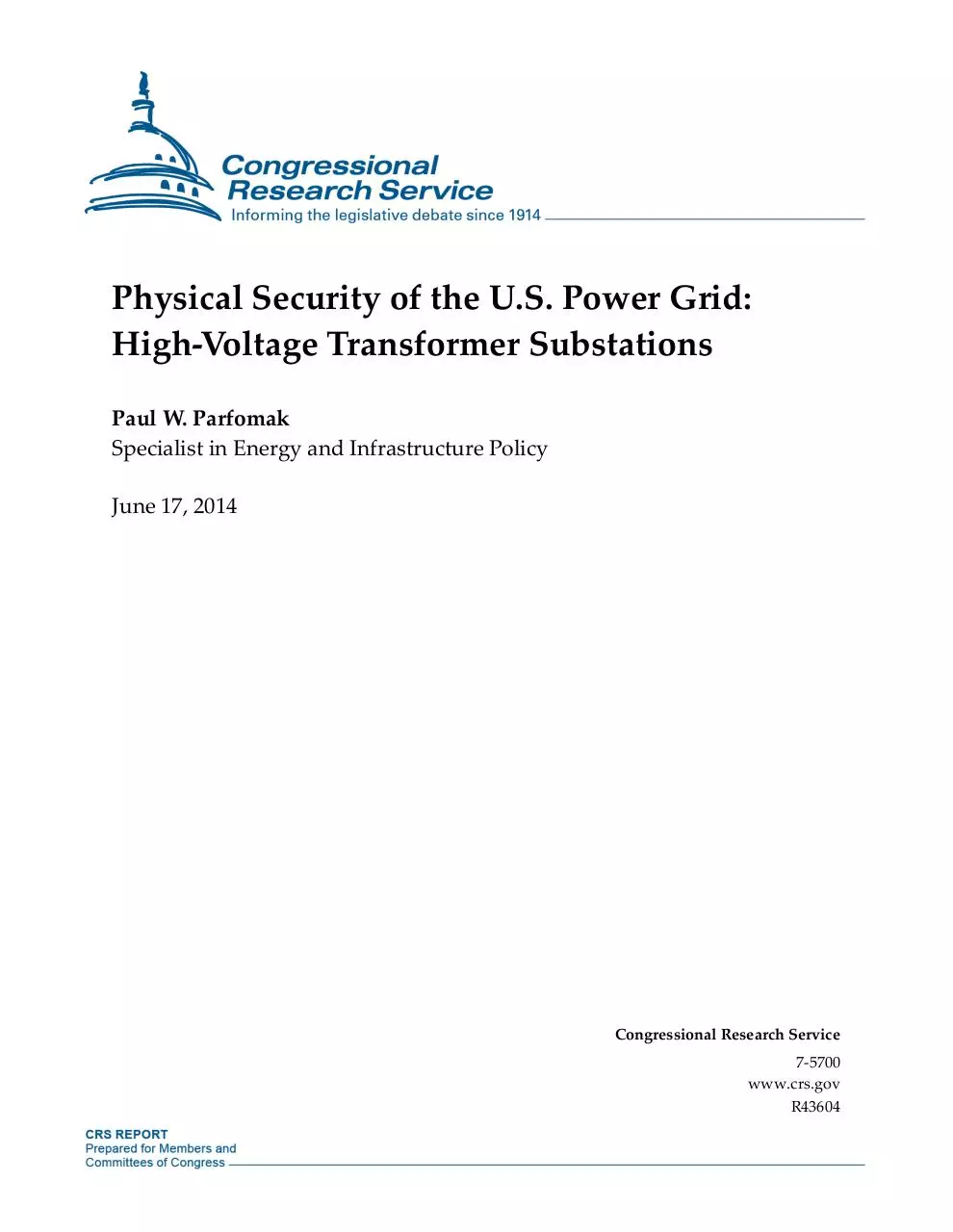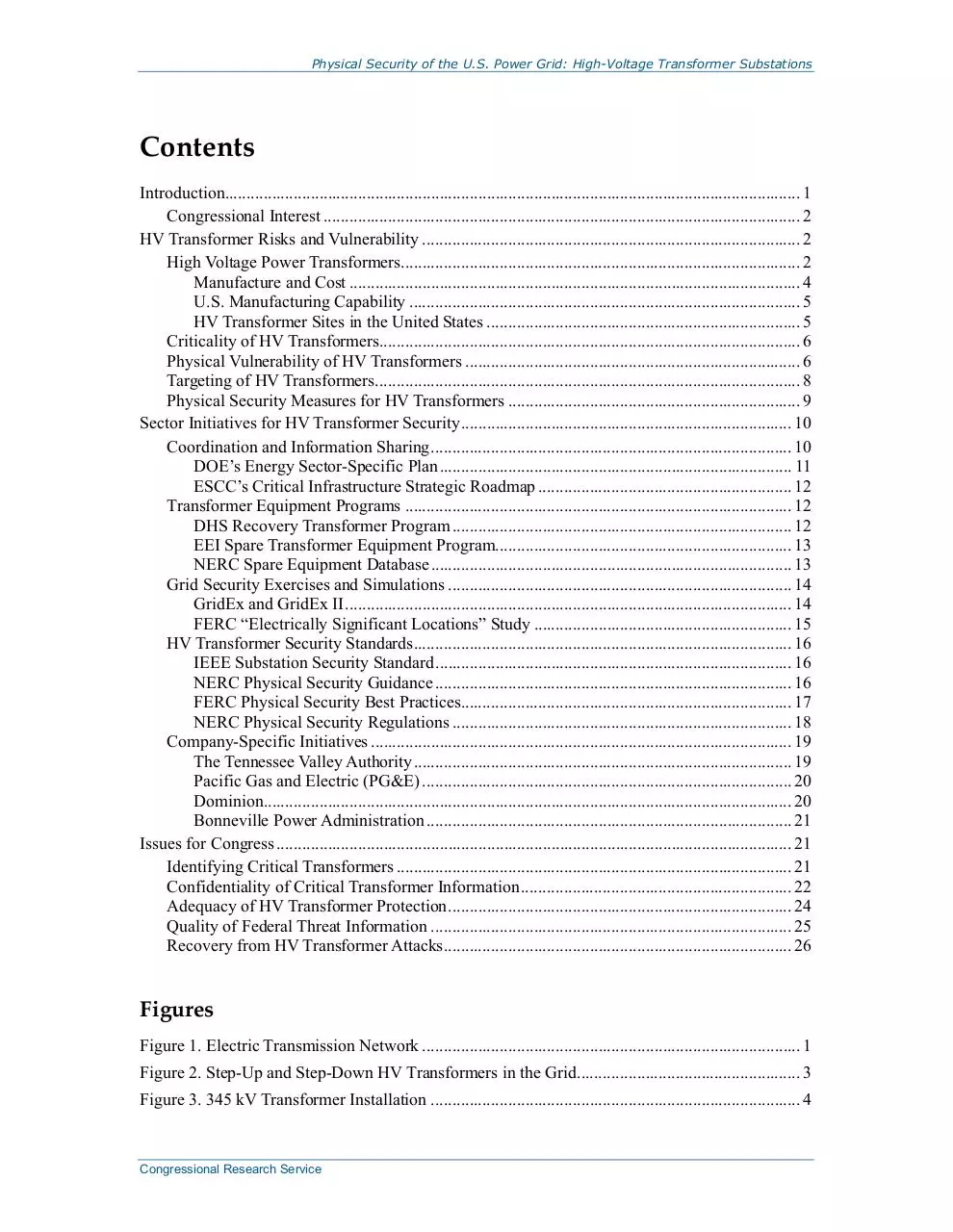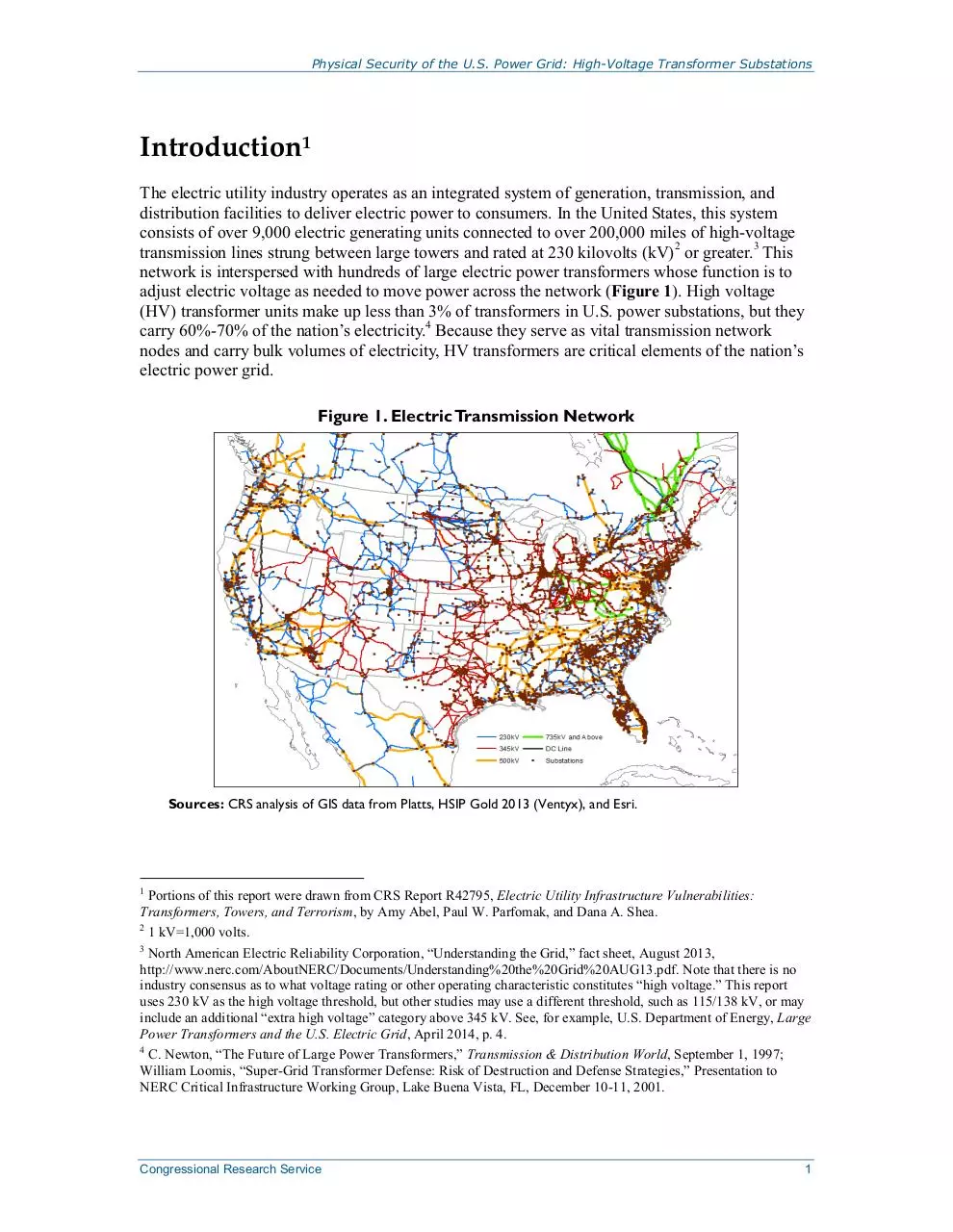nps71 070714 03 (PDF)
File information
Title: untitled
This PDF 1.4 document has been generated by / Acrobat Distiller 8.2.2 (Windows), and has been sent on pdf-archive.com on 22/02/2015 at 22:22, from IP address 31.6.x.x.
The current document download page has been viewed 733 times.
File size: 541.13 KB (30 pages).
Privacy: public file





File preview
Physical Security of the U.S. Power Grid:
High-Voltage Transformer Substations
Paul W. Parfomak
Specialist in Energy and Infrastructure Policy
June 17, 2014
Congressional Research Service
7-5700
www.crs.gov
R43604
Physical Security of the U.S. Power Grid: High-Voltage Transformer Substations
Summary
In the United States, the electric power grid consists of over 200,000 miles of high-voltage
transmission lines interspersed with hundreds of large electric power transformers. High voltage
(HV) transformer units make up less than 3% of transformers in U.S. power substations, but they
carry 60%-70% of the nation’s electricity. Because they serve as vital nodes and carry bulk
volumes of electricity, HV transformers are critical elements of the nation’s electric power grid.
HV transformers are also the most vulnerable to intentional damage from malicious acts. Recent
security exercises, together with a 2013 physical attack on transformers in Metcalf, CA, have
focused congressional interest on the physical security of HV transformers. They have also
prompted new grid security initiatives by utilities and federal regulators. Legislative proposals,
notably the Grid Reliability and Infrastructure Defense Act (H.R. 4298 and S. 2158), would
expand these efforts by strengthening federal authority to secure the U.S. grid.
For more than 10 years, the electric utility industry and government agencies have engaged in a
number of initiatives to secure HV transformers from physical attack and to improve recovery in
the event of a successful attack. These initiatives include coordination and information sharing,
spare equipment programs, security standards, grid security exercises, and other measures. There
has been some level of physical security investment and an increasing refinement of voluntary
grid security practices across the electric power sector for at least the last 15 years. Several major
transmission owners have recently announced significant new initiatives specifically to improve
the physical security of critical transformer substations in light of the Metcalf attack.
On March 7, 2014, the Federal Energy Regulatory Commission (FERC) ordered the North
American Electric Reliability Corporation (NERC) to submit to the Commission new reliability
standards requiring certain transmission owners “to take steps or demonstrate that they have taken
steps to address physical security risks and vulnerabilities related to the reliable operation” of the
power grid. In its order, FERC states that physical security standards are necessary because “the
current Reliability Standards do not specifically require entities to take steps to reasonably protect
against physical security attacks.” According to FERC’s order, the new reliability standards will
require grid owners to perform risk assessments to identify their critical facilities, evaluate
potential threats and vulnerabilities, and implement security plans to protect against attacks.
There is widespread agreement among state and federal government officials, utilities, and
manufacturers that HV transformers in the United States are vulnerable to terrorist attack, and that
such an attack potentially could have catastrophic consequences. But the most serious, multitransformer attacks would require acquiring operational information and a certain level of
sophistication on the part of potential attackers. Consequently, despite the technical arguments,
without more specific information about potential targets and attacker capabilities, the true
vulnerability of the grid to a multi-HV transformer attack remains an open question. Incomplete
or ambiguous threat information may lead to inconsistency in physical security among HV
transformer owners, inefficient spending of limited security resources at facilities that may not
really be under threat, or deployment of security measures against the wrong threat.
As the electric power industry and federal agencies continue their efforts to improve the physical
security of critical HV transformer substations, Congress may consider several key issues as part
of its oversight of the sector: identifying critical transformers, confidentiality of critical
transformer information, adequacy of HV transformer protection, quality of federal threat
information, and recovery from HV transformer attacks.
Congressional Research Service
Physical Security of the U.S. Power Grid: High-Voltage Transformer Substations
Contents
Introduction...................................................................................................................................... 1
Congressional Interest ............................................................................................................... 2
HV Transformer Risks and Vulnerability ........................................................................................ 2
High Voltage Power Transformers............................................................................................. 2
Manufacture and Cost ......................................................................................................... 4
U.S. Manufacturing Capability ........................................................................................... 5
HV Transformer Sites in the United States ......................................................................... 5
Criticality of HV Transformers.................................................................................................. 6
Physical Vulnerability of HV Transformers .............................................................................. 6
Targeting of HV Transformers................................................................................................... 8
Physical Security Measures for HV Transformers .................................................................... 9
Sector Initiatives for HV Transformer Security ............................................................................. 10
Coordination and Information Sharing .................................................................................... 10
DOE’s Energy Sector-Specific Plan .................................................................................. 11
ESCC’s Critical Infrastructure Strategic Roadmap ........................................................... 12
Transformer Equipment Programs .......................................................................................... 12
DHS Recovery Transformer Program ............................................................................... 12
EEI Spare Transformer Equipment Program..................................................................... 13
NERC Spare Equipment Database .................................................................................... 13
Grid Security Exercises and Simulations ................................................................................ 14
GridEx and GridEx II ........................................................................................................ 14
FERC “Electrically Significant Locations” Study ............................................................ 15
HV Transformer Security Standards........................................................................................ 16
IEEE Substation Security Standard ................................................................................... 16
NERC Physical Security Guidance ................................................................................... 16
FERC Physical Security Best Practices............................................................................. 17
NERC Physical Security Regulations ............................................................................... 18
Company-Specific Initiatives .................................................................................................. 19
The Tennessee Valley Authority ........................................................................................ 19
Pacific Gas and Electric (PG&E) ...................................................................................... 20
Dominion........................................................................................................................... 20
Bonneville Power Administration ..................................................................................... 21
Issues for Congress ........................................................................................................................ 21
Identifying Critical Transformers ............................................................................................ 21
Confidentiality of Critical Transformer Information ............................................................... 22
Adequacy of HV Transformer Protection ................................................................................ 24
Quality of Federal Threat Information .................................................................................... 25
Recovery from HV Transformer Attacks ................................................................................. 26
Figures
Figure 1. Electric Transmission Network ........................................................................................ 1
Figure 2. Step-Up and Step-Down HV Transformers in the Grid.................................................... 3
Figure 3. 345 kV Transformer Installation ...................................................................................... 4
Congressional Research Service
Physical Security of the U.S. Power Grid: High-Voltage Transformer Substations
Contacts
Author Contact Information........................................................................................................... 26
Congressional Research Service
Physical Security of the U.S. Power Grid: High-Voltage Transformer Substations
Introduction1
The electric utility industry operates as an integrated system of generation, transmission, and
distribution facilities to deliver electric power to consumers. In the United States, this system
consists of over 9,000 electric generating units connected to over 200,000 miles of high-voltage
transmission lines strung between large towers and rated at 230 kilovolts (kV)2 or greater.3 This
network is interspersed with hundreds of large electric power transformers whose function is to
adjust electric voltage as needed to move power across the network (Figure 1). High voltage
(HV) transformer units make up less than 3% of transformers in U.S. power substations, but they
carry 60%-70% of the nation’s electricity.4 Because they serve as vital transmission network
nodes and carry bulk volumes of electricity, HV transformers are critical elements of the nation’s
electric power grid.
Figure 1. Electric Transmission Network
Sources: CRS analysis of GIS data from Platts, HSIP Gold 2013 (Ventyx), and Esri.
1
Portions of this report were drawn from CRS Report R42795, Electric Utility Infrastructure Vulnerabilities:
Transformers, Towers, and Terrorism, by Amy Abel, Paul W. Parfomak, and Dana A. Shea.
2
1 kV=1,000 volts.
3
North American Electric Reliability Corporation, “Understanding the Grid,” fact sheet, August 2013,
http://www.nerc.com/AboutNERC/Documents/Understanding%20the%20Grid%20AUG13.pdf. Note that there is no
industry consensus as to what voltage rating or other operating characteristic constitutes “high voltage.” This report
uses 230 kV as the high voltage threshold, but other studies may use a different threshold, such as 115/138 kV, or may
include an additional “extra high voltage” category above 345 kV. See, for example, U.S. Department of Energy, Large
Power Transformers and the U.S. Electric Grid, April 2014, p. 4.
4
C. Newton, “The Future of Large Power Transformers,” Transmission & Distribution World, September 1, 1997;
William Loomis, “Super-Grid Transformer Defense: Risk of Destruction and Defense Strategies,” Presentation to
NERC Critical Infrastructure Working Group, Lake Buena Vista, FL, December 10-11, 2001.
Congressional Research Service
1
Physical Security of the U.S. Power Grid: High-Voltage Transformer Substations
The U.S. electric power grid has historically operated with such high reliability that any major
disruption, either caused by weather, operational errors, or sabotage, makes news headlines. Such
outages can have considerable negative impacts on business, government services, and daily life.
Notwithstanding its high reliability overall, the U.S. power grid has periodically experienced
major regional outages. Recent examples include the Northeast Blackout of 2003 (which affected
55 million customer in eight states and Canada) and extended outages in the New York/New
Jersey area after Superstorm Sandy in 2012.
Congressional Interest
The various parts of the electric power system are all vulnerable to failure due to natural or
manmade events. However, for reasons discussed below, HV transformers are considered by
many experts to be the most vulnerable to intentional damage from malicious acts. Congress has
long been concerned about grid security in general, but recent security exercises, together with a
2013 physical attack on transformers in Metcalf, CA, have focused congressional interest on the
physical security of HV transformers, among other specific aspects of the grid.5 They have also
prompted new grid security initiatives by utilities and federal regulators. Recent legislative
proposals, notably the Grid Reliability and Infrastructure Defense Act (H.R. 4298 and S. 2158),
would expand these efforts by strengthening federal authority to secure the U.S. grid. The
physical security of HV transformers and associated policy issues are the subject of this report.
HV Transformer Risks and Vulnerability
The main risk from a physical attack against the electric power grid—primarily towers and
transformers—is a widespread power outage lasting for days or longer. Utilities regularly
experience damage to transmission towers due to both weather and malicious activities and are
able to recover from this damage fairly rapidly. Thus, while occasionally causing blackouts,
physical attacks on towers generally have not resulted in widespread or long-lasting outages.
Likewise, the power industry has experienced mechanical failure of individual HV transformers
within a single control area resulting in blackouts lasting hours. However, no region in the United
States has experienced simultaneous failures of multiple HV transformers. Experts have long
asserted that a coordinated and simultaneous attack on multiple HV transformers could have
severe implications for reliable electric service over a large geographic area, crippling its
electricity network and causing widespread, extended blackouts. Such an event would have
serious economic and social consequences. This section discusses in more detail HV transformer
characteristics and physical security risks associated with them.
High Voltage Power Transformers
Utility transformers control the voltage of electricity so that it can be synchronized with other
power supplies, transmitted long distances, and distributed to customers. Transformers range in
size from small, pole-mounted units that may serve a dozen homes to transmission units that
serve an entire city. The larger the transformer, the higher the voltage the transformer can handle.
5
See, for example: Senators Dianne Feinstein, Al Franken, Ron Wyden, and Harry Reid, letter to the Honorable Cheryl
LaFleur, Acting Chairman, Federal Energy Regulatory Commission, February 7, 2014, http://www.ferc.gov/industries/
electric/indus-act/reliability/chairman-letter-incoming.pdf.
Congressional Research Service
2
Physical Security of the U.S. Power Grid: High-Voltage Transformer Substations
Utility transformers, regardless of size, fundamentally consist of copper wire wrapped around a
metallic “core” within an insulated protective housing covered with a 5/8 to 3/4-inch mild steel
tank. They are linked to the power grid by protruding metal and (usually) ceramic connectors
called “bushings” which resemble giant spark plugs. Larger transformers generate waste heat
during operation, so they are cooled by a system of internally circulating oil and external
radiators, analogous to the cooling system in a car engine. Transmission transformers are located
in network substations along with transmission lines, associated electric equipment, and system
controls. These substations may be found in remote locations or near urban centers, depending
upon regional transmission needs. Many are located alongside electric generation plants, linking
those plants to the grid.
Voltage Management in the U.S. Power System
Electricity produced at U.S. generating stations is converted into a set of three alternating electric currents called
three-phase power.6 The first step in delivering this power is transforming it from the generated voltage (typically 1550 kV) to higher voltage (138-765 kV), allowing transmission over long distances in greater volumes most efficiently
(Figure 2).7 This initial voltage step-up occurs by means of transformers located at transmission substations adjacent
to the generating facilities. (The three phases of power are carried separately over three wires on transmission
towers.) Close to the ultimate consumer, the power is stepped-down at another transformer substation to lower
voltages, typically 13 kV or less. At this point, the power is considered to have left transmission and entered the local
distribution system.
Figure 2. Step-Up and Step-Down HV Transformers in the Grid
Source: Adapted by CRS from: U.S.-Canada Power System Outage Task Force, Final Report on the August 14,
2003 Blackout in the United States and Canada: Causes and Recommendations, April 2004, Figure 2.1.
High-voltage transformers, especially units above 345 kV, are physically large and extraordinarily
heavy. For example, Figure 3 shows a new 345 kV transformer many times larger than the pickup
truck parked alongside. This transformer unit weighs 435 tons, including 29,000 gallons of
cooling oil.8 (Note that the vertical bushings are not yet connected to transmission lines because
the unit is being moved.) This is a three-phase unit, with one bushing for each of the three phases.
Some substations alternatively employ separate single-phase transformers in sets of three.
6
The three currents are sine wave functions of time with the same frequency (60 Hertz). The phases are spaced equally,
offset 120 degrees from each other. With three-phase power, one of the phases is always nearing a peak.
7
The loss of power on the transmission system is proportional to the square of the current (flow of electricity) while the
current is inversely proportional to the voltage.
8
Pauwels Canada, Inc., personal communication, October 20, 2003.
Congressional Research Service
3
Physical Security of the U.S. Power Grid: High-Voltage Transformer Substations
Generally, the higher the transformer’s voltage, the larger the transformer. A three-phase 765kV
transformer could be 45 feet tall and occupy a footprint of 2,200 square feet—about the size of an
average new single-family house.9
Figure 3. 345 kV Transformer Installation
Source: Courtesy of Pauwels Canada, Inc., 2003.
Manufacture and Cost
Most HV transformers are unique and therefore are designed and manufactured to custom
specifications for a specific network application. In 2010, the lead time between an HV
transformer order and delivery ranged from 5 to 12 months for U.S. manufacturers and 6 to 16
months for foreign manufacturers, although lead times well over 20 months could be required in
certain situations.10 This process may include three to four months for the engineering design
alone.11 Since manufacturing generally occurs on a single production line with just-in-time
component supplies, advanced production scheduling is important for managing delivery.
Physical assembly is labor intensive, requiring manual winding of the copper wire around the
transformer core and frequent engineering checks during manufacturing. Extensive testing of
completed units also contributes to HV transformer manufacturing time.
The installed cost for an HV transformer depends heavily on its configuration and specific design
requirements. New HV transmission substations can cost well in excess of $10 million, including
the cost of transformers and other station equipment. According to the U.S. Department of Energy
(DOE), the factory prices for HV transformers typically range from $2 million for a 230 kV unit
to $7.5 million for a 765 kV unit, before transportation and installation costs.12
9
U.S. Department of Energy, April 2014, p. 7.
U.S. Department of Energy, April 2014, p. 9.
11
Pauwels Canada, Inc., October 20, 2003.
12
U.S. Department of Energy, April 2014, p. 7.
10
Congressional Research Service
4
Physical Security of the U.S. Power Grid: High-Voltage Transformer Substations
U.S. Manufacturing Capability
From 1950 to 1970, utility construction of large generation plants and associated transmission
networks fueled a robust U.S. manufacturing market for large transformers. During this period,
the United States (and Canada) accounted for approximately 40% of global demand for such
units.13 After 1970, however, utility investment in transmission infrastructure began falling off
due to perceived overcapacity, public resistance to transmission siting, and greater regulatory
scrutiny of capital expenditures. Beginning in the late 1980s, uncertainty about industry
restructuring and the introduction of competition made grid owners even less willing to invest in
new transmission. This decline in U.S. transmission investment greatly reduced domestic demand
for large transformers, especially HV transformers. By the late 1990s, the United States and
Canada accounted for only 20% of global large transformer sales.14 Demand in the United States
has subsequently increased, however. For example, between 2005 and 2013, the total value of
large transformers (including medium- and high-voltage units) imported to the United States
more than doubled, from $284 million (363 units) to $676 million (496 units).15
At the same time, global demand for transformers continued to grow and more foreign
manufacturers entered the market. According to U.S. industry representatives, many of these
foreign manufacturers benefited from dramatically lower labor costs, so they could underbid U.S.
transformer makers for the remaining U.S. demand. Some of these foreign manufacturers may
have been protected by import barriers which effectively closed their home markets to U.S.
transformer imports. Today, there is limited manufacturing capacity in the United States for HV
transformers. Five U.S. facilities state that they can manufacture transformers rated 345 kV or
above, although it is not clear how many units in this range they have actually produced. Canada
and Mexico have five additional HV manufacturing plants.16 While limited domestic HV
transformer manufacturing may increase delivery time, utilities have not reported difficulty in
obtaining needed equipment.
HV Transformer Sites in the United States
There are several thousand HV transformers operating in the United States. Approximately 2,100
are very large units rated 345 kV and above.17 Investor-owned utilities own most of these,
although public utilities such as the Power Marketing Administrations (i.e., Bonneville Power
Administration and Western Area Power Administration), Tennessee Valley Authority, and the
Los Angeles Department of Water and Power own many HV transformers as well.18 HV
transformer substations are distributed throughout the electric grid, as shown in Figure 1, with
the greatest number in the eastern part of the country.
13
C. Newton, “The Future of Large Power Transformers,” Transmission & Distribution World, September 1, 1997.
C. Newton, September 1, 1997.
15
U.S. Department of Energy, April 2014, p. 27.
16
Kenneth Friedman, U.S. Department of Energy, “DOE Update on GMD/EMP-Related Activities,” Presentation to
the Geomagnetic Disturbance Task Force Working Group, North American Electric Reliability Corporation, November
13, 2013.
17
John Kappenman, Geomagnetic Storms and Their Impacts on the U.S. Power Grid, Meta-R-319, Metatech Corp.,
prepared for Oak Ridge National Laboratory, January 2010, p. 1-14, http://www.ferc.gov/industries/electric/indus-act/
reliability/cybersecurity/ferc_meta-r-319.pdf.
18
HV substation information for specific investor-owned utilities is publicly available in annual reports filed with the
Federal Energy Regulatory Commission (FERC Form-1).
14
Congressional Research Service
5
Download nps71-070714-03
nps71-070714-03.pdf (PDF, 541.13 KB)
Download PDF
Share this file on social networks
Link to this page
Permanent link
Use the permanent link to the download page to share your document on Facebook, Twitter, LinkedIn, or directly with a contact by e-Mail, Messenger, Whatsapp, Line..
Short link
Use the short link to share your document on Twitter or by text message (SMS)
HTML Code
Copy the following HTML code to share your document on a Website or Blog
QR Code to this page

This file has been shared publicly by a user of PDF Archive.
Document ID: 0000210864.